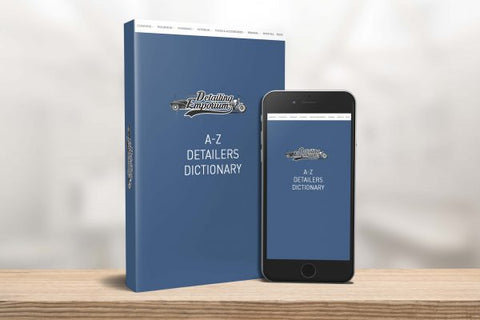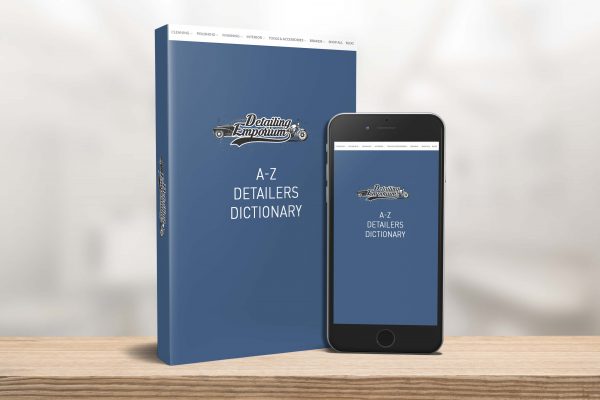
Whether you’re new to the world of detailing or have been on the scene for years, some of the slang and abbreviations used can often be a bit confusing!
Our ultimate guide or ‘detailers dictionary’ should help you navigate your way through the forums and facebook groups in confidence! So, to make sure you know your APC’s from your fallout removers…read on!
Abrasive: The fine gritty content in a compound or polish which is present to remove scratches and imperfections in paint or clearcoat
Acrylic: Content in the formula of a PTFE (Teflon) based product, often referred to as a sealant, which provides a gloss finish and durable protection to paint and clearcoat.
AIO: All In One, a product with multiple functions like cleaners (to clean surface), abrasives (to correct scratches), oil (to make dark colors deeper and warmer) and teflon (to bring shine and protection to paints and clearcoat
APC: All Purpose Cleaner. A cleaner for multiple surfaces and applications. Don’t be fooled into thinking because it’s multi-purpose it wont be any good for your application. Many APC’s are excellent all rounders and shouldn’t be discounted. Some can be used inside and out for jobs like cleaning floor mats, interior trim, tyres, wheels and so on.
Applicator: A foam or microfiber pad which can be used to apply waxes, sealants or dressings by hand.
Beading: The Holy Grail! Beading is the much sought after effect among car care enthusiasts where water beads on the surface of your paintwork.
Buffing: A technique which is used to remove residue from an applied product like wax or sealant. You can buff by hand or with a buffing machine.
Carnauba: Seen as the highest quality automotive wax. Waxes with high percentages of carnauba wax will be more expensive and generally speaking of better quality. Interestingly Carnauba wax, because of its hydrophobic properties was used to coat speedboat hulls and surfboards to increase speed through the water!
Clay Bar: A clay bar is a malleable natural or synthetic putty or clay that detailers use to remove contaminants from smooth surfaces that washing cannot remove. The idea being to remove all dirt and contamination before polishing so that you don’t damage surfaces further by dragging dirt around as you polish.
A Clay – Bar works together with a Clay Lubricant to lubricate the surface.
Cleaner: Products with cleaning and sometimes degreasing properties. Cleaners are used to prepare surfaces for maximum adhesion of waxes and sealants.
Contamination: Pollution, particles and Oxidation that are bonded or embedded into a surface giving the surface a rough feeling to the touch. Contamination or fallout can be removed in most cases with washing and subsequent use of a clay bar and clay bar lubricant.
Compound: A polish with a powerful abrasive to remove large paint – defects.
Detailing: The term used in the UK and Ireland for intensive cleaning and restoration of cars, bikes and trucks.
Dry Aid: A spray drying technique with a Detail Spray to be used after rinsing the car and before drying to reduce friction from the drying – towel and improve shine while drying.
Fillers: Ingredients found in Glaze . Fillers can mask swirls and micro – scratches.
Snow Foam Gun / Snow Foam Lance: The tool used to apply snow foam. Most commonly they attache to a pressure washer but you can get manual pressurised snow foam guns. A snow foam gun Comprises of a reservoir (to hold the snow foam) and a spray nozzle. Snow foam is used as a pre wash to soften and lift dirt away from the surface before washing
Wash Mitt: A car wash mitt (often made from microfiber) to be used for car washing by hand. Designed to lift dirt away from the surface and trap it in the fibres so that it cannot cause scratches or swirls.
Glaze: An oil based product which often includes fillers and delivers extra shine to (dark – colored) paint.
Grit Guard: A super invention, the Grit Guard can be added to the bottom of your car wash bucket which keeps washed off contamination separate from your washing solution.
Haze: A haze which arises after the curing of a wax or sealant.
Hologrammes: Micro scratches caused by improper washing or after use of a powerful compound which are visible under a strong light.
Lubrication: A technique to reduce the friction between the paint and pad (with polisher) to avoid micro – scratches. Lubricants are also required when using a clay bar to help the clay glide over the surface and to stop marring.
2 Bucket Method: A safe technique for washing. 1 Bucket for shampoo and 1 Bucket for rinsing. Usually used in conjunction with grit guards in the buckets.
Marring: Light clearcoat damage which arises sometimes while claying with a medium or heavy clay bar.
Microfiber: You can get all kinds of microfiber products – towels, mitts, pads and cloths. They’re popular because the deep fibres do an excellent job of lifting and holding dirt away from the painted surface to avoid scratching
Neutral: Usually meaning PH neutral – think back to chemistry class! Products that are neither alkaline or acidic meaning they are safe for use on delicate surfaces such as expensive polished alloy wheel rims for example.
HPW: High-Pressure Washer
Orbital: A machine polisher which makes orbital movements to imitate the natural movement of your hand. These polishers create less heat and therefore bring less risks then rotary – polishers.
Pad: An accessory in foam or microfiber to apply various products.
Orange Peel: The dimpled finish you often see in a painted surface – more prominent in water based paints. Many brand new cars leave the factory with a a certain amount of orange peel. Some brand and colours are worse than others.
Polisher: A power tool with a rotary or orbital motion used to polish paint or metal more quickly and efficiently than by hand.
Polish: An abrasive product which brings shine back to painted surfaces. Many different grades of polish are available with different levels of abrasive compound in them. For example, an old car with scratches and faded paint might need a more abraisive polish than a bran new car.
PTG: Paint Thickness Gauge, a measurement tool to determine the paint thickness.
Rotary: A polishing machine which has a circular movement, not an orbital movement.
Sealant: A synthetic, wax-like product based on polymers (PTFE / Teflon) for durable protection.
Shampoo: A car wash product designed to wash the vehicle, soften and lift dirt away from the surface and remove oxidation and grime.
Sheeting: The discharge time of water on a body panel which is important for good protection.
Water spots: Marks caused by drying of shampoo or ‘hard’ water that is heavily alkaline that is on the surface.. Can e remedied by proper drying techniques.
Swirls: Micro scratches in a circular or V shape.
Clear Coat: The transparent layer of lacquer applied over paint to protect against UV, heat, and solvents.
Waffle Weave: A type of weave found in certain Microfiber drying towels which have a dimpled surface to dry the vehicle surface with minimal contact.
Water Blade: An accessory for a quick drying job on flat and clean surfaces.
Wet Sanding: A technique to sand paint with highly abrasive products. This technique is useful in the case of large scratches or when refinishing paints.

